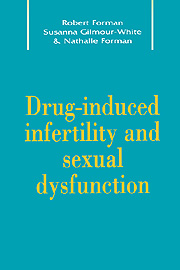8 - Recreational drugs and drugs of abuse
Published online by Cambridge University Press: 30 March 2010
Summary
Tobacco
Tobacco is the most significant reproductive poison in current use. It is estimated that each year in North America there are 100 000 fetal deaths, 5000 congenital malformations and 200 000 babies who are born growth retarded as a consequence of maternal cigarette smoking (Hughes, 1994). Given this enormous effect on pregnancy outcome, it would be surprising if smoking did not also have some influence on the ability to conceive. However, despite the huge number of smokers it has proved impossible to reach definitive conclusions of the influence of smoking on conception. There are several reasons for this.
Smoking is more likely to be associated with other factors that can influence fertility, such as pelvic infection and the use of alcohol and caffeine. Small retrospective trials are of inadequate statistical power to reach valid conclusions and only a few large prospective studies have been performed. The design of the studies may introduce bias. One, for example, investigating the effect of smoking on sperm count, selected smokers from an infertility clinic whereas non-smoking controls were selected from men of proved fertility (Vine et al.9 1994).
Studies have concentrated on the effects of smoking by men on their sperm parameters, on the chances of conception in women smokers and, more recently, on the influence of smoking on the results of in vitro fertilisation. These areas will be reviewed separately.
Effects on sperm
Several reports mention negative effects of nicotine on sperm. One investigation in fertility clinic patients reported that 41% of smokers had reduced sperm density compared with 26% of non-smokers.
- Type
- Chapter
- Information
- Drug-Induced Infertility and Sexual Dysfunction , pp. 106 - 123Publisher: Cambridge University PressPrint publication year: 1996



